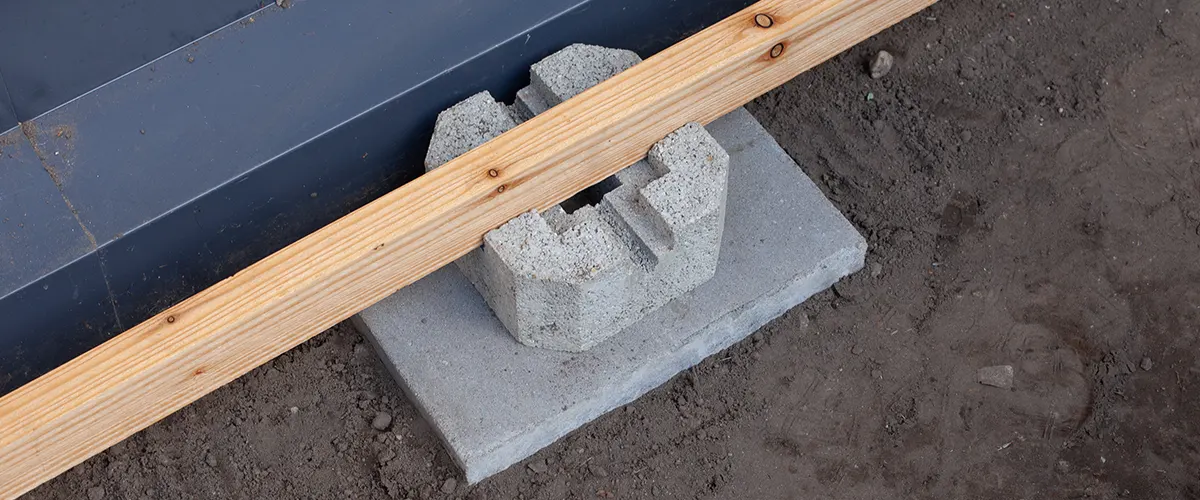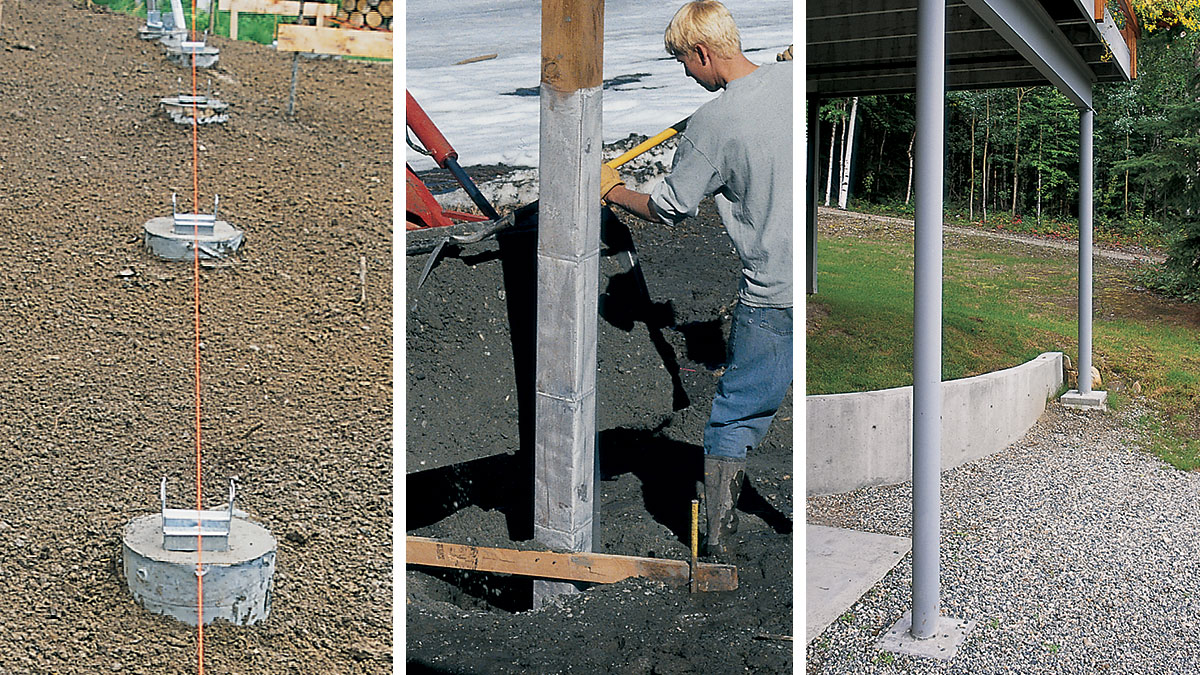From Concept to Concrete: The Vital Duty of Deck Footings in Sturdy and Safe Decks
Selecting the Right Deck Footings for Security and Durability
The longevity and safety of your deck depend greatly on the type of footings you choose, as they offer the essential support and security to hold up against the examination of time. In this discussion, we will certainly discover the numerous kinds of deck footings, consider the crucial elements to consider when making a choice, and delve into the pros and cons of various options.
Kinds Of Deck Grounds
These grounds are composed of a cylindrical opening loaded with concrete, which gives a solid foundation for the deck posts. Concrete pier footings are relatively very easy to mount and use superb security, making them a popular option for many deck tasks.
One more type of footing is the helical stack ground. Helical piles are steel shafts with helical plates attached to them. These footings are mounted by screwing them right into the ground, which produces a safe and secure foundation for the deck. Helical pile grounds are suitable for areas with challenging soil problems, as they can be mounted in nearly any kind of sort of dirt. They also enable for very easy modification and progressing of the deck if required.
Alternatively, some contractors go with precast concrete grounds. These grounds are made from long lasting concrete and be available in different sizes and shapes to accommodate different deck styles. Precast concrete grounds are convenient to mount and supply a steady base for the deck framework.
Finally, one more option is the post-in-anchor footing system. This kind of footing entails driving a metal support into the ground and affixing it to the deck message. It offers versatility in terms of placing the deck articles and is suitable for decks with lightweight structures.
When picking the best sort of deck footing, it is necessary to think about factors such as soil problems, deck load, and neighborhood building regulations (Deck Footings). Consulting with a professional contractor or architectural engineer can aid ensure the suitable ground is selected for a steady and safe deck
Aspects to Consider When Picking Footings
When selecting the appropriate footings for a deck, it is vital to thoroughly take into consideration numerous factors such as dirt problems, deck load, and adherence to local building ordinance. These aspects play a substantial role in making certain the security and durability of the deck framework.
The type of dirt on which the deck will be developed identifies the type of footings called for. On the other hand, decks developed on clay or expansive soils might need footings that can accommodate the dirt's tendency to increase and agreement.
An additional crucial aspect is the deck tons. The weight of the deck, consisting of the products made use of and any type of prospective real-time tons such as furniture or celebrations, must be considered when selecting footings. The grounds should be created to birth the weight of the deck and distribute it uniformly to stop any architectural concerns or failures.
Last but not least, adherence to regional building regulations is vital. Building ordinance vary from region to region, and it is necessary to follow the particular requirements established by the regional authorities. This Site Deck Footings. These codes make sure that the deck is constructed safely and satisfies the needed standards for architectural integrity and load-bearing capacity
Concrete Footings: Disadvantages and pros

Concrete footings offer a number of benefits and downsides when utilized as the structure for a deck. On the favorable side, concrete grounds supply exceptional security and sturdiness.
Another advantage of concrete grounds is their convenience. They can be poured right into various forms and sizes to accommodate different deck styles and setups. Concrete footings can be personalized to fit the details demands and requirements of the deck framework.
Nonetheless, there are also some drawbacks to utilizing concrete grounds. This can boost the he has a good point overall price of the deck job and may call for professional assistance.

Helical Piers Vs. Sonotubes: Which Is Much better?
In considering the structure options for a deck, the comparison between helical piers and sonotubes is critical in determining the superior choice. They are twisted right into the ground using hydraulic machinery, supplying a steady and durable structure for the deck.
The helical plates on the piers develop a solid grip with the dirt, avoiding any motion or moving of the deck. Sonotubes, on the various other hand, count solely on the concrete filling for stability, which may not offer the very same level of strength and resistance.
In regards to installation, helical piers are relatively less complicated and faster to mount compared to sonotubes. The hydraulic equipment utilized to twist the piers right into the ground makes certain a effective and fast procedure. Sonotubes, on the various other hand, require excavating openings and pouring concrete, which can be labor-intensive and taxing.
Furthermore, helical piers are a more flexible alternative. If needed, they can be used in numerous dirt conditions and can be readjusted or strengthened. Sonotubes, on the various other hand, might require additional assistance, such as rebar, in specific dirt problems or areas with high lots requirements.
Picking the Right Footings for Your Deck's Dimensions
For ideal structural integrity, it is important to thoroughly pick the suitable footings that align with the measurements of your deck. The measurements of your deck, including its elevation, size, and length, play a considerable role in figuring out the type and dimension of footings called for.
When choosing grounds for your deck, it is essential to think about the load-bearing capability of the soil. The weight of the deck, combined with the weight of any type of furnishings or individuals on it, applies a substantial force on the grounds (Deck Footings). For that reason, it is crucial to pick footings that can appropriately support this weight without changing or sinking over official source time.
Bigger decks with better dimensions need bigger footings to supply adequate stability and support. The form of the grounds, whether they are round or square, depends on the design and design of the deck.
Conclusion
In verdict, picking the right deck grounds is essential for making certain security and sturdiness. Variables such as the kind of grounds, the deck's measurements, and the pros and disadvantages of various options need to be considered. Concrete grounds offer toughness and durability, but might be more pricey and taxing to set up. Helical piers and sonotubes have their own benefits and drawbacks. Inevitably, picking the ideal grounds for your deck's particular requirements is crucial for a effective and lasting framework.
These grounds consist of a round opening filled with concrete, which provides a strong foundation for the deck blog posts. Concrete pier grounds are relatively very easy to install and supply outstanding security, making them a prominent choice for several deck tasks.
Precast concrete grounds are practical to install and give a stable base for the deck framework.
It provides adaptability in terms of placing the deck posts and is ideal for decks with lightweight structures.
Concrete footings supply numerous advantages and disadvantages when used as the structure for a deck.